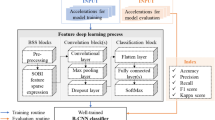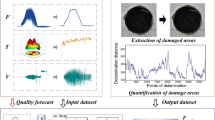Abstract
This paper presents a multi-sensor feature fusion (MSFF) neural network comprised of two inception layer-type multiple channel feature fusion (MCFF) networks for both inner-sensor and cross-sensor feature fusion in conjunction with a deep residual neural network (ResNet) for accurate grease life assessment and bearings health monitoring. The single MCFF network is designed for low-level feature extraction and fusion of either vibration or acoustic emission signals at multi-scales. The concatenation of MCFF networks serves as a cross-sensor feature fusion layer to combine extracted features from both vibration and acoustic emission sources. A ResNet is developed for high-level feature extraction from the fused feature maps and prediction. Besides, to handle the large volume of collected data, original time-series data are transformed to the frequency domain with different sampling intervals and targeted ranges. The proposed MSFF network outperforms other models based on different fusion methods, fully connected network predictors and/or a single sensor source.







Similar content being viewed by others
Explore related subjects
Discover the latest articles and news from researchers in related subjects, suggested using machine learning.Data availability
The datasets generated during and/or analyzed during the current study are available from the corresponding author on reasonable request.
Abbreviations
- AE:
-
Acoustic emission
- FFT:
-
Fast Fourier transform
- FC:
-
Fully connected
- MCFF:
-
Multiple channel feature fusion
- MSFF:
-
Multiple sensor feature fusion
- RDF:
-
Raw data fusion
- ResNet:
-
Residual neural network
- SCFF:
-
Single-channel feature fusion
- VB:
-
Vibration signal
- L :
-
Grease life
- \(T_{c}\) :
-
Temperature
- \(S_{g}\) :
-
Half-life subtraction factor
- N :
-
Shaft speed
- \(\frac{DN}{(DN)_{L}}\) :
-
Speed penalty
- D :
-
Average bearing diameter
- W :
-
Radial load
- C :
-
Specific dynamic capacity
References
Elasha F, Greaves M, Mba D (2018) Planetary bearing defect detection in a commercial helicopter main gearbox with vibration and acoustic emission. Struct Health Monit 17(5):1192–1212
Qiao M, Yan S, Tang X, Xu C (2020) Deep convolutional and LSTM recurrent neural networks for rolling bearing fault diagnosis under strong noises and variable loads. IEEE Access 17:66257–66269
Zhang S, Zhang S, Wang B, Habetler TG (2020) Deep learning algorithms for bearing fault diagnostics: a comprehensive review. IEEE Access 8:29857–29881
Wu S, Jing X, Zhang Q, Wu F, Zhao H, Dong Y (2020) Prediction consistency guided convolutional neural networks for cross-domain bearing fault diagnosis. IEEE Access 8:120089–120103
Schwack F, Bader N, Leckner J, Demaille C, Poll G (2020) A study of grease lubricants under wind turbine pitch bearing conditions. Wear 454:203335–203347
Wu C, Yang K, Chen Y, Ni J, Yao L, Li X (2020) Investigation of friction and vibration performance of lithium complex grease containing nano-particles on rolling bearing. Tribol Int 155:106761–106774
Yucesan YA, Viana FAC (2021) Hybrid physics-informed neural networks for main bearing fatigue prognosis with visual grease inspection. Comput Ind 125:103386–103399
Booser E, Khonsari M (2010) Grease life in ball bearings: the effect of temperatures. Tribol Grease Technol 10:36–44
Dykas B, Hood A, Nenadic N, Zhu E (2019) Diagnostic features from aircraft propulsion bearings in accelerated aging experiments. In: Proceedings of the vertical flight society 75th annual forum and technology display, Philadelphia, USA
Shi Z, Liu J (2020) An improved planar dynamic model for vibration analysis of a cylindrical roller bearing. Mech Mach Theory 153:103994–104006
Immovilli F, Bellini A, Rubini R, Tassoni C (2010) Diagnosis of bearing faults in induction machines by vibration or current signals: a critical comparison. IEEE Trans Ind Appl 46(4):1350–1359
Randall RB, Antoni J (2011) Rolling element bearing diagnostics: a tutorial. Mech Syst Signal Process 25:485–520
Motahari-Nezhad M, Jafari SM (2021) Bearing remaining useful life prediction under starved lubricating condition using time domain acoustic emission signal processing. Expert Syst Appl 168:114391–114403
König F, Sous C, Chaib A, Jacobs G (2021) Machine learning based anomaly detection and classification of acoustic emission events for wear monitoring in sliding bearing systems. Tribol Int 155:106811–106823
Sikorska JZ, Mba D (2008) Challenges and obstacles in the application of acoustic emission to process machinery. Proc Inst Mech Engi Part E J Process Mech Eng 222(1):1–19
Tan CK, Irving P, Mba D (2007) A comparative experimental study on the diagnostic and prognostic capabilities of acoustics emission, vibration and spectrometric oil analysis for spur gears. Mech Syst Signal Process 21:208–233
LeCun Y, Bengio Y, Hinton G (2015) Deep learning. Nature 512(7553):436–444
Janssens O, Slavkovikj V, Vervisch B, Stockman K, Loccufier M, Verstockt S, Walle RV, Hoecke S (2016) Convolutional neural network based fault detection for rotating machinery. J Sound Vib 377:331–345
Chen C, Liu Z, Yang G, Wu C, Ye Q (2021) Convolutional neural network based fault detection for rotating machinery. Electronics 10(59):2034–2053
Yang K, Zhao L, Wang C (2022) A new intelligent bearing fault diagnosis model based on triplet network and SVM. Sci Rep 12(1):5234
Pan J, Zi Y, Chen J, Zhou Z, Wang B (2018) LiftingNet: a novel deep learning network with layerwise feature learning from noisy mechanical data for fault classification. IEEE Trans Ind Electron 65(6):4973–4982
Wang B, Feng G, Hong D, Kang Y (2022) A bearing fault diagnosis method based on spectrum map information fusion and convolutional neural network. Processes 10(7):1426
Shao H, Jiang H, Li X, Wu S (2018) Intelligent fault diagnosis of rolling bearing using deep wavelet auto-encoder with extreme learning machine. Knowl Based Syst 140:1–14
Shao H, Jiang H, Zhang H, Liang T (2018) Electric locomotive bearing fault diagnosis using a novel convolutional deep belief network. IEEE Trans Ind Electron 65(3):2727–2736
Pan H, He X, Tang S, Meng F (2018) An improved bearing fault diagnosis method using one-dimensional CNN and LSTM. J Mech Eng 64(7–8):443–452
Liu Q, Ma G, Cheng C (2020) Data fusion generative adversarial network for multi-class imbalanced fault diagnosis of rotating machinery. IEEE Access 8:70111–70124
Martin GS, Droguett EL, Meruane V, Moura M (2018) Deep variational auto-encoders: a promising tool for dimensionality reduction and ball bearing elements fault diagnosis. Struct Health Monit 18(4):1092–1128
Hou L, Jiang R, Tan Y, Zhang J (2020) Input feature mappings-based deep residual networks for fault diagnosis of rolling element bearing with complicated dataset. IEEE Access 8:180967–180976
Chen Z, Li W (2017) Multisensor feature fusion for bearing fault diagnosis using sparse autoencoder and deep belief network. IEEE Trans Instrum Meas 66(7):1693–1702
Zhao K, Jiang H, Li X, Wang R (2019) An optimal deep sparse autoencoder with gated recurrent unit for rolling bearing fault diagnosis. Meas Sci Technol 31(1):015005
Li S, Wang J, Li X (2019) An unsupervised learning method for bearing fault diagnosis based on sparse feature extraction. In: IEEE proceedings of the prognostics and system health management conference, Qingdao, China
Mahadik K, Wang nad Q, Li S, Sabne A (2020) Fast distributed bandits for online recommendation systems. In: Proceedings of the 34th ACM international conference on supercomputing, Barcelona, Spain
Li S, Karatzoglou A, Gentile C (2016) Collaborative filtering bandits. In: Proceedings of the 39th international ACM SIGIR conference on research and development in information retrieval, Pisa, Italy
Li H, Huang J, Ji S (2019) Bearing fault diagnosis with a feature fusion method based on an ensemble convolutional neural network and deep neural network. Sensors 19(9):2034–2052
Wang X, Mao D, Li X (2021) Bearing fault diagnosis based on vibro-acoustic data fusion and 1D-CNN network. Measurement 173:108518–108530
Xu X, Tao Z, Ming W, An Q, Chen M (2021) Intelligent monitoring and diagnostics using a novel integrated model based on deep learning and multi-sensor feature fusion. Measurement 165:108086–108099
Qiao H, Wang T, Wang P, Qiao S, Zhang L (2018) A time-distributed spatiotemporal feature learning method for machine health monitoring with multi-sensor time series. Sensors 18(9):2932–2952
Duan Z, Wu T, Guo S, Shao T, Malekian R, Li Z (2018) Development and trend of condition monitoring and fault diagnosis of multi-sensors information fusion for rolling bearings: a review. Int J Adv Manuf Technol 96(1):803–819
Liu J, Hu Y, Wang Y, Wu B, Fan J, Hu Z (2018) An integrated multi-sensor fusion based deep feature learning approach for rotating machinery diagnosis. Meas Sci Technol 29(5):055103
Sadoughi M, Hu C (2019) Physics-based convolutional neural network for fault diagnosis of rolling element bearings. IEEE Sens J 19(11):4181–4192
Jing L, Wang T, Zhao M, Wang P (2019) An adaptive multi-sensor data fusion method based on deep convolutional neural networks for fault diagnosis of planetary gearbox. Sensors 17(2):414
Szegedy C, Liu W, Jia Y, Sermanet P, Reed S, Anguelov D, Erhan D, Vanhoucke V, Rabinovich A (2015) Going deeper with convolutions. In: Proceedings of the IEEE conference on computer vision and pattern recognition (CVPR), Boston, MA, USA
Ioffe S, Szegedy C (2015) Batch normalization: accelerating deep network training by reducing internal covariate shift. In: Proceedings of the international conference on machine learning
He K, Zhang X, Ren S, Sun J (2016) Deep residual learning for image recognition. In: Proceedings of the IEEE conference on computer vision and pattern recognition (CVPR), Las Vegas, NV, USA
Zhai S, Wu H, Kumar A, Cheng Y, Lu Y, Zhang Z, Feris R (2017) S3Pool: pooling with stochastic spatial sampling. In: Proceedings of the IEEE conference on computer vision and pattern recognition (CVPR), Honolulu, HI, USA
Kumar SK (2017) On weight initialization in deep neural networks. arXiv:1704.08863v2
Author information
Authors and Affiliations
Corresponding author
Ethics declarations
Conflict of interest
The authors declare that they have no conflict of interest.
Additional information
Publisher's Note
Springer Nature remains neutral with regard to jurisdictional claims in published maps and institutional affiliations.
This work was performed at University of South Carolina when Zhuocheng Jiang and Seong Hyeon Hong worked there as postdocs.
Rights and permissions
Springer Nature or its licensor (e.g. a society or other partner) holds exclusive rights to this article under a publishing agreement with the author(s) or other rightsholder(s); author self-archiving of the accepted manuscript version of this article is solely governed by the terms of such publishing agreement and applicable law.
About this article
Cite this article
Jiang, Z., Hong, S.H., Albia, B. et al. A multi-sensor feature fusion network model for bearings grease life assessment in accelerated experiments. Neural Comput & Applic 35, 5923–5937 (2023). https://doi.org/10.1007/s00521-022-07982-z
Received:
Accepted:
Published:
Issue Date:
DOI: https://doi.org/10.1007/s00521-022-07982-z




